Exploring Agricultural Drainage Systems for Sustainability
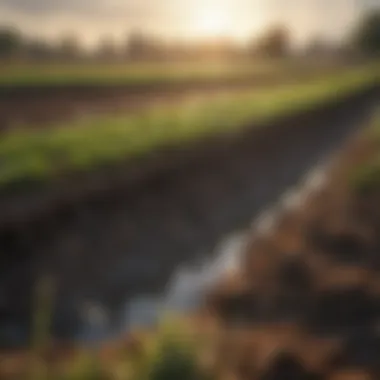
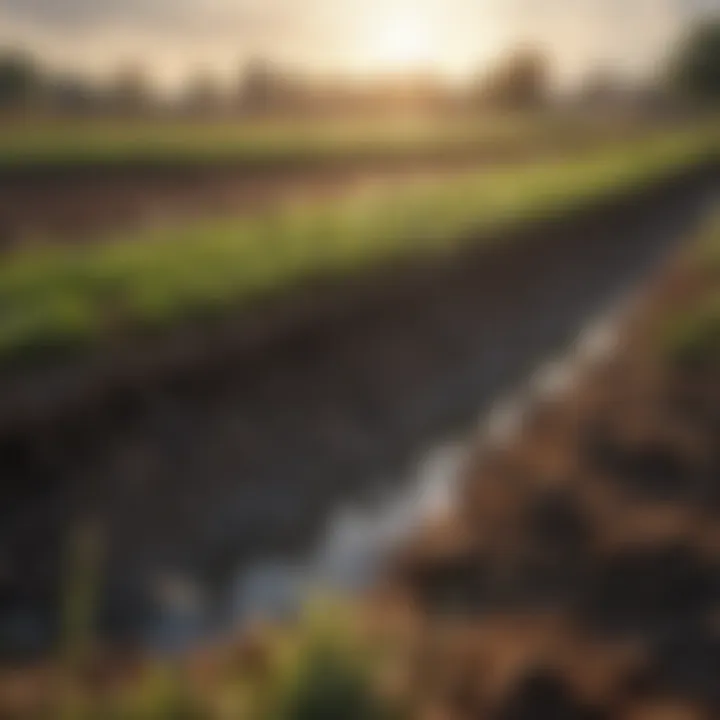
Intro
Effective drainage is crucial in agriculture. It not only improves soil health but also affects crop yield and sustainability. As farmers face increasing challenges from climate change, understanding different types of drainage systems becomes vital. In this article, we delve into these systems that could determine the success of agricultural practices.
Overview of the Topic
Definition and Importance
Drainage in agriculture refers to the process of removing excess water from the soil. This is essential because too much water can hinder plant growth, cause root rot, and affect soil structure. By implementing proper drainage, farmers can enhance crop productivity and maintain soil integrity.
Current Trends
Recently, there has been a shift towards sustainable drainage practices. These practices aim to minimize environmental impacts while maximizing agricultural benefits. Innovations such as controlled drainage and bioretention systems are gaining traction. They help in managing excess water while promoting ecological balance.
Key Techniques and Practices
Step-by-Step Guide
- Assessment: Begin with a thorough evaluation of the land to determine the type of drainage needed.
- Design: Create a system tailored to specific agricultural needs. Consider factors such as soil type, topography, and water table levels.
- Implementation: Use appropriate methods like tile drainage, surface drainage, or subsurface drainage systems to remove excess water. Ensure proper installation to avoid future issues.
- Maintenance: Regularly check the drainage systems for blockages or failures. Routine maintenance is key to long-term effectiveness.
Tools and Equipment Needed
To implement effective drainage systems, several tools are necessary:
- Excavators: For digging trenches for tile drainage.
- Pipe Couplers: Used in tile drainage for proper connection.
- Leveling Instruments: Ensure correct installation of drainage systems.
Challenges and Solutions
Common Obstacles
Farmers often face various challenges related to drainage systems. These include:
- High initial costs for installation
- Maintenance complexity over time
- Potential soil erosion or degradation
Innovative Solutions
To address these challenges, some solutions are valuable:
- Cost-Effective Designs: Develop simplified designs that reduce installation costs.
- Community Initiatives: Engage in group projects to share resources and knowledge for better drainage practices.
- Technology Integration: Utilize technology for monitoring and managing drainage systems efficiently.
Proper drainage management can significantly enhance agricultural productivity and contribute to long-term ecological balance.
In summary, a robust understanding of agricultural drainage systems is essential for modern farming practices. The next sections will explore these systems in detail, providing insights that can help farmers make informed decisions.
Understanding the Importance of Drainage
In agriculture, effective drainage systems are pivotal to ensuring the success of various farming operations. They play a crucial role in managing water at both the surface and subsurface levels, thereby addressing excess water and preventing waterlogging. Drainage is not merely about removing excess water; it involves creating a healthy environment that promotes optimal crop growth and soil health. Investing in proper drainage techniques can yield substantial benefits, which may ultimately lead to enhanced profitability for farmers.
Role of Drainage in Agriculture
The role of drainage in agriculture is multi-faceted. It allows farmers to manage soil moisture levels efficiently, ensuring that crops receive the right amount of water without drowning in excess. Excess moisture can hinder root growth, reduce oxygen availability, and cause stress to plants. By applying appropriate drainage techniques, farmers can mitigate these issues, allowing plants to thrive.
Furthermore, drainage systems enable agricultural land to be more usable. Fields that are prone to flooding can be transformed into productive areas, suitable for a variety of crops. In many cases, improved drainage can extend the planting season, allowing for earlier planting and potentially increasing yields.
A well-established drainage system can also aid in managing erosion. Water can cause substantial soil loss, particularly in hilly regions or areas with loose soil. By controlling water flow, drainage systems can minimize erosion risks, thus preserving the land and its nutrients.
Impact on Soil Health and Crop Yield
Soil health is intrinsically tied to proper drainage management. Well-drained soil enhances aeration, which promotes better root development and nutrient absorption. Adequate drainage prevents the compacting of soil, which can hinder root expansion and water infiltration. Conversely, waterlogged conditions can lead to anaerobic environments that foster harmful anaerobic bacteria, negatively impacting soil vitality.
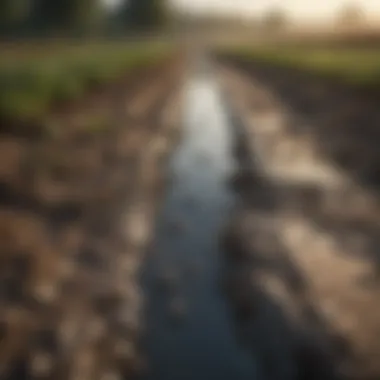
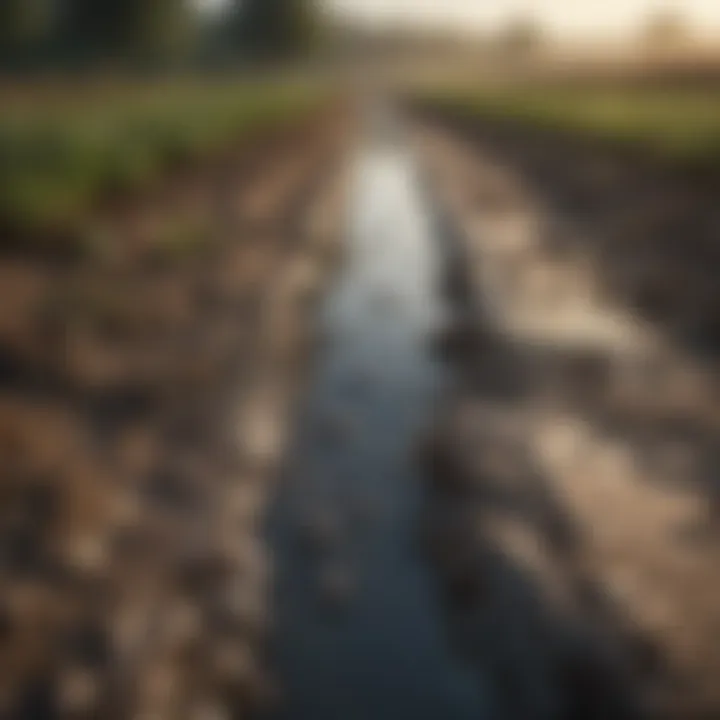
In terms of crop yield, studies have consistently shown that implementing effective drainage solutions leads to higher productivity. Crops in well-drained areas typically exhibit improved health, which translates into higher yields. A direct correlation exists between soil moisture management and crop performance.
"Sound drainage practices are essential for both soil health and optimal crop yield, creating a path to sustainable farming."
By understanding the significance of drainage, farmers can make informed decisions about their agricultural practices. Utilizing appropriate drainage systems not only supports immediate crop needs but also contributes to long-term sustainability within the agricultural sector.
Types of Drainage Systems
Understanding the types of drainage systems is crucial to effective agricultural practices. This knowledge helps farmers manage water effectively, ensuring that crops receive the necessary moisture without facing waterlogging or dry conditions. Proper drainage can directly influence soil health, crop yield, and overall land sustainability.
Surface Drainage
Definition and Mechanism
Surface drainage involves constructing channels or ditches that direct excess water away from the field. The primary goal is to remove standing water, which can harm crops and impede their growth. The key characteristic of surface drainage is its simplicity; it relies on gravity to transport water away. This type of drainage is popular, especially in flat or gently sloping areas, due to its cost-effectiveness and ease of installation. A significant feature is that it can be used in combination with other systems enhancing overall water management. While beneficial, the disadvantages include potential erosion and the need for regular maintenance to ensure channels remain unobstructed.
Applications in Agriculture
Surface drainage systems are widely applied in regions where congested water accumulates. They are especially useful on soils with low permeability. Farmers favor this system for row crops and pastureland as it can quickly mitigate temporary flooding. Additionally, surface drainage can prevent soil degradation by removing excess moisture that could lead to a decline in plant health. But, implementing such systems requires careful planning considering the risk of soil erosion and sediment transport.
Advantages and Disadvantages
The advantages of surface drainage include its low cost and straightforward implementation. This encourages many farmers to adopt it, especially in small to medium-sized operations. Furthermore, it can enhance the soil microbial activity due to better aeration. However, there are disadvantages such as the scattered water can lead to uneven moisture distribution in the field. Also, heavy rainfall might overwhelm the capacity of these systems, causing failures.
Subsurface Drainage
Understanding Tile Drainage
Subsurface drainage uses buried pipes, often referred to as tile drains, to remove excess water beneath the soil surface. This method allows for controlled drainage, preventing waterlogging while maintaining necessary moisture levels for crop health. The unique feature of tile drainage is its ability to improve soil structure by promoting aeration and enhancing root growth. They are particularly advantageous for heavy clay soils that retain moisture. The disadvantage lies in the high installation costs and potential for clogging over time, requiring periodic maintenance.
Cultural Practices Involving Subsurface Techniques
Farmers integrating subsurface drainage often adopt specific cultural practices to maximize efficiency. These can include crop rotation and soil amendments that improve drainage functionality. The key characteristic of these practices is that they build a holistic management system. They emphasize nutrient management while ensuring water balance in crops. Techniques like cover cropping can augment subsurface drainage effectiveness, but these practices require education and continued commitment from farmers.
Environmental Considerations
Environmental impacts of subsurface drainage are crucial to consider. While it alleviates waterlogged conditions, it may also lead to leaching of nutrients and contaminants into groundwater. The key characteristic involves balancing productivity while mitigating adverse environmental impacts. Management practices must align agricultural needs with sustainability goals to avoid over-reliance on this system. Potential regulations and guidelines can shape how farmers adopt subsurface techniques, adding complexity to their application.
French Drains
Construction and Setup
French drains consist of a trench filled with gravel or rock, directing water away from a specific area. The primary aspect of their construction is the use of perforated pipes to capture excess water from the soil. A notable advantage of the French drain setup is its efficiency in redirecting landscape runoff. The setup process can be labor-intensive, requiring precise grading and considerable excavation. However, this system has longevity if established correctly, reducing the frequency of maintenance.
Best Use Cases in Farming
These drains are ideal in areas with high moisture levels, particularly where crops face risk of saturation. Farmers use French drains to protect lower-lying fields and to manage stormwater. The key characteristic here is their adaptability; they can be installed in various soil types. However, improper installation can limit effectiveness, making education on setup crucial to farmers.
Potential Drawbacks
Despite advantages, French drains also have drawbacks. They can be expensive concerning initial setup and require proper planning to ensure optimal performance. Maintenance is necessary to prevent clogging from silt and organic matter. Farmers must weigh these challenges against the benefits, knowing that poor installation could lead to costly repairs.
Green Roof and Rainwater Gardens
Benefits for Urban Agriculture
Green roofs and rainwater gardens serve multiple purposes in urban settings, enhancing water management and supporting biodiversity. They help mitigate urban heat islands while providing natural water filtration. The main benefit entails capturing rainwater, which can then be used for irrigation purposes. Farmers looking to engage in urban agriculture find these systems valuable for promoting sustainability and ecological awareness.
Design and Implementation
The design of green roofs involves layer construction for optimal drainage and plant health. Essential elements include a waterproof membrane and a drainage layer to control water management within the system. Urban farmers tend to favor this design due to its dual function in plant cultivation and efficient water use. However, they require thoughtful planning regarding plant selection and structural support to sustain the ecosystem.


Maintenance Guidelines
Regular maintenance is key to ensuring the longevity and effectiveness of green roofs and rainwater gardens. Routine checks for drainage efficiency and plant health are crucial. The main characteristic of maintaining these systems is proactive care, including weeding and soil replenishment. Urban farmers may find the benefits worthwhile, but ongoing commitment is necessary to achieve desired outcomes.
Design Considerations for Drainage Systems
When establishing effective drainage systems in agriculture, several design considerations must be taken into account. The proper design of these systems is essential for enhancing agricultural productivity and ensuring sustainability. Key elements include soil types, topographic features, and climatic conditions, all of which play pivotal roles in determining the most effective drainage solutions.
Soil Types and Their Influence
Soils vary in texture and composition, which directly impacts their drainage capabilities. Sandy soils, for instance, tend to drain quickly, allowing water to move through with relative ease. Conversely, clay soils hold water more effectively, posing challenges such as waterlogging.
Understanding the specific soil type helps farmers choose the right drainage method. For example:
- Sandy Soil: Increased surface drainage options might be suitable.
- Clayey Soil: Subsurface drainage, such as tile systems, could be beneficial to remove excess water.
Farmers often conduct soil tests to determine drainage requirements. This aids in avoiding over-compaction during planting or cultivation, which further impairs drainage.
Topography and Landscape Factors
Topography significantly affects water flow and drainage systems. The slope of the land influences water runoff and infiltration rates. Steep slopes may lead to rapid drainage but can cause erosion, while flat terrains could be prone to water accumulation.
Key considerations regarding topography include:
- Land Slope: Sloped areas may necessitate terracing or contour farming to manage drainage effectively.
- Water Flow Paths: Understanding natural water pathways can facilitate the design of drainage systems that align with these flows.
Moreover, incorporating landscape factors, like the presence of vegetation, can enhance drainage systems. Vegetated areas can act as buffers, absorbing excess moisture and reducing runoff while promoting aeration in soil.
Climatic Conditions
The local climate is a crucial factor in drainage system design. Regions with heavy rainfall demand different strategies than areas experiencing prolonged dry spells. Understanding climatic patterns is vital for effective planning.
Consider the following climatic factors:
- Rainfall Intensity: Frequent heavy rains could warrant immediate surface drainage solutions like ditches or trenches.
- Seasonal Variations: Areas with snowmelt will require drainage solutions that accommodate melting snow to prevent spring flooding.
Regular monitoring of climatic data assists in adjusting existing drainage systems and preparing for extreme weather events, such as heavy storms.
In summary, integrating these design considerations ensures that drainage systems are tailored to the unique needs of a farm. This leads to better management of water resources, enhanced soil health, and increased agricultural productivity.
"A well-designed drainage system not only prevents crop damage but also preserves soil nutrients, playing a pivotal role in sustainable farming practices."
Sustainable Practices in Drainage Management
Sustainable practices in drainage management are critical for modern agriculture. This approach is centered on the principle that agricultural systems must not only be productive but also environmentally viable. As the global demand for food increases, it becomes imperative to adopt methods that preserve soil health, promote biodiversity, and protect water resources. The integration of sustainable drainage practices allows farmers to maintain crop yields while minimizing adverse effects on the environment.
Adopting sustainable practices can lead to significant benefits. One major advantage is the improvement in soil quality. Properly managed drainage systems help mitigate water-logging, which can smother roots and hinder plant growth. Another benefit is the enhancement of water retention in soil, which supports crops during dry periods. Moreover, sustainable drainage practices often involve the use of natural materials and methods, promoting a healthy ecosystem and reducing reliance on synthetic inputs.
Considerations surrounding sustainable drainage are diverse and complex. For example, farmers must be aware of the unique characteristics of their land and the crops they cultivate. Understanding the specific drainage needs of different crops helps in selecting suitable systems. Furthermore, a farmer's practices can directly impact local water bodies. Practices like controlled drainage can significantly reduce nutrient runoff, helping to maintain water quality in surrounding ecosystems.
"Sustainable drainage practices enhance agricultural productivity while promoting soil health and water conservation."
In summary, sustainable drainage management is not merely an alternative—it is essential for the future of agriculture. It challenges farmers to think critically about their practices and the ripple effects on the environment. The integration of these practices is a step towards achieving ecological balance, ensuring that agriculture remains viable for generations to come.
Integrating Drainage with Agronomy
Integrating drainage systems with agronomy is a vital aspect of sustainable farming. This integration starts with an understanding of the relationship between soil drainage, water management, and plant growth. Different crops have varying water requirements and tolerances. Hence, assessing the specific needs of each crop is necessary for designing an efficient drainage system. By aligning agronomic practices with drainage design, farmers can optimize conditions for crop development and enhance yields.
Moreover, crop rotation and selection can impact the effectiveness of drainage systems. For instance, deep-rooted crops can help improve soil structure and allow better water infiltration. This relationship demonstrates the synergy between good agronomy and effective drainage management. When farmers prioritize both drainage and crop production methods, they create a productive system that supports healthy soils.
Utilizing Biology for Improved Drainage
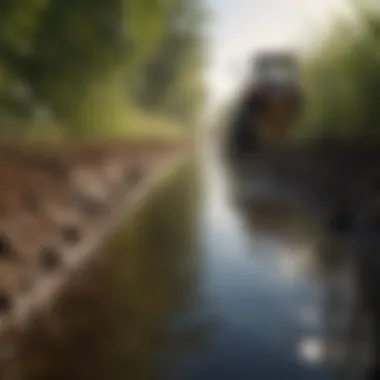

Utilizing biology as part of drainage strategy presents innovative solutions to traditional problems. Biological practices can include the introduction of specific plant species that promote drainage and enhance soil structure. For example, cover crops like radishes can break up compacted soil and improve water movement while also reducing erosion.
Another biological method is the use of microbial communities to assist in nutrient cycling. Certain bacteria and fungi can enhance soil structure, making it less susceptible to erosion and improving its ability to manage water. By fostering these biological systems, farmers not only combat drainage issues but also enhance the resilience and productivity of their fields.
Challenges Associated with Drainage Systems
Drainage systems are crucial for maintaining agricultural productivity. However, their implementation is not without challenges. Understanding these difficulties can help farmers and agronomists develop better strategies for drainage management. Issues such as waterlogged conditions and soil erosion are significant concerns that need attention. These challenges can diminish crop yield and affect soil ecosystems, making this section essential for grasping the full scope of drainage management in agriculture.
Waterlogged Conditions and Their Effects
Waterlogging occurs when excessive water accumulates in the soil, which can lead to several detrimental effects. Poor drainage systems often fail to remove surplus water effectively, causing roots to suffocate in the saturated environment. This lack of oxygen can significantly hinder plant growth, leading to reduced crop yields.
Key points regarding waterlogged conditions include:
- Oxygen deficit: Roots cannot absorb necessary nutrients. This condition leads to stunted plant development.
- Disease susceptibility: Waterlogged soils promote root rot and other plant diseases. These diseases can spread quickly, jeopardizing entire crops.
- Seedling mortality: New plants are often unable to survive prolonged saturation, reducing overall plant establishment.
Clear management practices must be emphasized to combat waterlogged situations. There is a need for regular monitoring of soil moisture levels and timely adjustments to drainage layouts. Use of buffer strips, wetlands, and appropriate plant choices may mitigate this phenomenon.
Soil Erosion and Nutrient Loss
Soil erosion is another pressing issue linked to drainage. When water flows too rapidly over the soil surface, it can wash away the nutrient-rich topsoil. This erosion not only diminishes soil quality but also impacts the overall health of the agricultural ecosystem.
When discussing soil erosion, consider these aspects:
- Nutrient depletion: Eroded soil often carries essential nutrients away, leading to poorer crop productivity.
- Water quality degradation: Soil particles washed into nearby water bodies lead to sedimentation. This sediment can harm aquatic ecosystems and pollute drinking water supplies.
- Increased input costs: Farmers may need to invest more in fertilizers and soil amendments to counteract nutrient loss.
To address these challenges, implementing proper erosion control measures is vital. Techniques such as contour farming, the use of cover crops, and maintaining vegetation buffers along waterways can help retain topsoil. These practices not only protect the soil but also promote healthier crop growth.
"Sustainable drainage systems must focus on both mitigating excess water and protecting soil health to ensure long-term agricultural productivity."
By understanding both waterlogged conditions and soil erosion, farmers can take proactive steps to improve their drainage strategies, enhance crop yield, and support healthier soil ecosystems.
Future Trends in Drainage Practices
In the evolving field of agriculture, understanding future trends in drainage practices is crucial for enhancing productivity and sustainability. This section discusses technological advancements and regulatory frameworks that are shaping the way agricultural drainage systems are implemented. As environmental concerns grow, farmers must adapt to new methods that optimize water management while minimizing adverse effects on ecosystems.
Technological Innovations in Drainage Systems
Technological innovations are pivotal for improving drainage systems in agriculture. Precision agriculture technologies, such as real-time soil moisture sensors and automated drainage systems, are becoming more prevalent. These innovations enable farmers to make data-driven decisions on drainage management, allowing for efficient water use and improved crop yields.
Benefits of these technologies include:
- Improved efficiency: Using sensors helps in accurately determining when to drain water, thus reducing wastage and optimizing resource use.
- Enhanced productivity: Better water management leads to healthier plants, higher yields, and consequently, increased profitability.
- Sustainability: Innovative techniques can reduce the need for chemical interventions, promoting a more environmentally friendly approach.
Furthermore, drone technology has also emerged in mapping and assessing drainage patterns. Drones can deliver insights that are not easily visible from the ground, helping identify problem areas within fields. This real-time monitoring can lead to more responsive farming practices.
Policy Developments and Regulations
Policies and regulations play a significant role in shaping drainage practices in agriculture. Governments worldwide are beginning to recognize the importance of sustainable water management in the agricultural sector. Regulations can drive changes that promote the adoption of best practices among farmers.
Key considerations include:
- Water regulations: Many regions are implementing stricter regulations on water usage and movement, encouraging farmers to adopt efficient drainage systems.
- Support for innovation: Grants and subsidies for farmers who invest in new drainage technologies are becoming more common. This support can make it easier for farmers to transition towards innovative approaches.
- Environmental assessments: Policy developments are increasingly requiring assessment of the environmental impact of drainage practices, ensuring that developments do not negatively affect local ecosystems.
"Emphasizing the interconnectedness of drainage practices and environmental health is essential for future agricultural sustainability."
End
The conclusion of this article is vital in encapsulating the key understandings associated with drainage systems in agriculture. It serves to unify the insights and knowledge gained throughout the various sections. The importance of effective drainage cannot be overstated. Proper systems can alleviate waterlogged conditions, improving soil health and crop yields while ensuring sustainability.
Summary of Key Insights
Each type of drainage system discussed plays a unique role in agricultural practices. For instance, surface drainage effectively manages excess water by redirecting it away from fields. Subsurface drainage helps to maintain optimal moisture levels by removing excess water below the soil surface. French drains can prevent water accumulation in specific areas, while green roofs and rainwater gardens support urban agriculture by managing stormwater sustainably. Understanding these systems facilitates appropriate management decisions by farmers, leading to heightened efficiency in resource use and improvement of crop production.
Call to Action for Sustainable Practices
Farmers and agricultural enthusiasts are encouraged to adopt sustainable practices involving drainage management. This involves not only selecting suitable systems but also maintaining them diligently. Implementing technologies that enhance efficiency and minimize environmental impact can significantly benefit agriculture. Regularly evaluating soil health and drainage effectiveness will aid in making informed decisions that improve both productivity and ecological balance. Collaborating with experts and staying updated on innovative drainage solutions can further contribute to a sustainable agricultural future.



